
Mar 31, 2001, The B. H. Manuscript/Collectible/Philatelic Sale, Sale 9

Lot 665
1734 Connecticut Will.
Manuscript Document Signed ("Thomas Bennit", "Tho
Towley"). One page, 7¾ x 11¼", Connecticut, April 18, 1733.
In brown ink. With partial wax seal. Two horizontal folds and three
vertical folds. Soiling along folds, yellowing from age. In fine
condition.
An early Connecticut citizen named Thomas Bennit, Sr.,
bequeaths his land in Newton, Connecticut to his son. The document is also
signed by Justice of the Peace, Thomas Towley.
Estimated Value
$150-250.
Lot 666
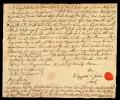

1777 Manumission of Two
Slaves. Document Signed (One Elizabeth Warder signs with her mark at
the lower right). One page, 7½ x 6¼", November 12, 1777. Being
a manumission of two slaves. In black ink. Original wax seal appears at the
lower right. Docketed verso. With two horizontal folds, a 1½" tear
that has been repaired at upper left and toning. Overall, in good
condition.
In following with the decrees of her faith, here a Quaker
widow named Elizabeth Warder grants her two slaves their freedom, stating:
"Elizabeth Warder ... do hereby set free from bondage my Negro woman
named Hannah aged about twenty one years, and I also set free from bondage
my Negro girl named Sarah aged two years the 25th day of the 6th month last
(being the daughter of my said Negro Hannah)..." Given the political
climate, Ms. Warder's act was actually ahead of its time as it would be
nearly one hundred years before the Thirteenth Amendment was adopted,
thereby abolishing slavery. However, the influence of her faith might have
played a part in her decision -- the Quakers were champions of the
anti-slavery movement, and began to strongly encourage members to release
their slaves after the 1776 All Quakers meeting for the Philadelphia
region. In fact, just four years later, the state of Pennsylvania (where
Warder and her slaves resided) passed a law that allowed for the gradual
abolition of slavery.
Estimated Value $600-800.
Lot 667
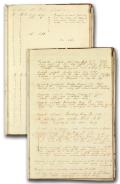

1849 Ship Log. Here
we offer a ship's log dating from April 18 through December 16, 1849.
Detailing the wind currents and weather conditions of each day, the captain
of the brig California meticulously included daily entries into this
log. Beginning in Havana, the log reports on voyages to New York, Boston,
and finally Pernambuco, Brazil. Politically unsettled at the time,
Pernambuco had revolted against Portuguese rulers just one year prior to
the ship's arrival. Though known for producing sugarcane and a variety of
tropical fruits, it appears from the log that cargo was actually
discharged, rather than taken aboard. While at port, the captain regularly
reports on the activities of the crew, mentioning when they mend sails,
discharge cargo, and attend to ship's duty. Hard bound, for an overall size
of 8½ x 12¾". On one page several lines of music have been
written in pencil with various scribblings, likely, a recent addition.
Several pages are loose or have split along binding, general toning of
brittle pages, soiling and wear. In good condition overall.
Estimated
Value $300-400.
Lot 668
1862 Diary of a Young
Woman. Here we offer the diary of one Miss Flora Driggs of Brocton, New
York. The leather bound journal, filled with accounts of daily activities
and observations, begins on January 5, 1862 and follows the life of Miss
Driggs through October of 1865. A frequent churchgoer and seamstress,
Driggs details her activities at school, her family life, and domestic
duties. This revealing diary is also filled with poignant historical
references, including her reaction to the news of Lincoln's assassination
on April 15, 1865. She writes: "Heard this morning the most painful
news. The death of our President Abraham Lincoln. Murdered at a
theater. Secretary Seward stabbed in bed. God permitted it, and therefore
we may know that he is able to make a good grow of it though me cannot see
how ... his name & goodness will ever be remembered and revered by
posterity." The covers are worn, spine repaired. In good to very
good condition overall.
Estimated Value $200-300.
Lot 669
1907 Coal Mining
Payroll Book. Payroll book of the Leigh & Wilkes-Barre Coal Company of
Pennsylvania. Covering the months of July, August, and September of 1907,
this detailed book records the payroll information of outside company
employees, inside company employees, and miners, listing each individual's
name, hours worked, pay scale, etc. Also detailed, are deductions made for
those miners who lived in company housing. Sixty-nine pages in total, each
features the company name at heading. Entries are made in black and red
ink, and are verified both by a foreman and outside superintendent. Spine
is Morocco leather gold stamped "Colliery No 4 July / August / September /
L&W B.C. Co. Honey Brook Division". Measuring 28½ x 18½".
General toning, but still in very good to fine condition.
The Leigh
& Wilkes-Barre Coal Company was one of eight major coal operators
dominating the coal industry at the turn of the century. Located in
Pennsylvania, the company was formed by Phillip Ginder after discovering
anthracite coal near Summit Hill in 1791. Unfortunately, the company was
the site of a violet strike-turned-massacre in 1897 over wage prices. Our
payroll book reflects an increase, albeit ten years later.
Estimated
Value $250-350.
Lot 670
A Confederate Veteran
Recalls Gettysburg and General Lee's Orders. Autograph Letter Signed
("Thos. B. Gatch").Two pages, 9 x 6½", Baltimore, December
13, 1920. To John Boos. Mailing folds, spot on second page, penciled
notation at upper left corner. In very good to fine condition.
A
remarkable Civil War reminiscence. Thomas Gatch, a First Sargeant in the
Seventh Virginia Cavalry (commanded by Turner Ashby), recalls meeting
Robert E. Lee as he and his detachment were crossing the Potomac on
their way to Gettysburg: "...I was in command of all the Cavalry in
immediate advance of Genl Lee's Army 30 men. Genl Lee rode up to me and
asked 'who is in command of this detachment,' I saluted & replied I am Sir,
he asked 'what is your rank' I replied 1st Sergt Sir, 'how many men have
you?' I replied 30 Sir, he then asked 'are they well mounted,' I answered I
suppose we were selected looking to our mounts He then said, 'you with your
detachment will remain at my Head Quarters as couriers until relieved. I
have issued Genl orders that all Citizens be treated with courtesy and that
no plundering of any kind is to be permitted. if you or any of your men
should witness any infraction of that order, I want them brought to my head
quarters & turned over to Col Marshal.': this is the only instance in which
I came in personal contact with Genl Lee. I was wounded at Fairfield
takeing[sic] a dispatch to our Cavalry...I was taken Prisoner during
Genl Earleys campaign in the Valley and spent the last 9 months of the war
in Fort Delaware which was worse than the war itself..." An impressive
first person account of a soldier's life and encounter with a legend.
Estimated Value $500-700.
Lot 671
Archive of Early Wanted
Posters. Eleven early American "Wanted Posters". Announcing fugitives
from Chicago, Denver, the Bay Area, and Southern California, each features
colorful descriptions of the "offenders" with corresponding images. These
interesting pieces of Americana give insight into early thievery, detailing
criminals such as the man who stole a horse in Burbank, California (the
horse expertly described as a "black gelding, 16-1/2 hands high; weighs
about 1,150 pounds, one upper front tooth gone, last shod with steel
shoes..."), as well as another swindler who stole diamonds and jewelry out
of a coffin. Conditions vary from poor to good.
Estimated Value
$75-100.
Lot 672
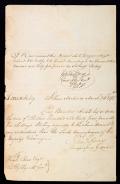

Arnold, Benedict.
British Pay Voucher (1741-1801). American Revolutionary War hero who
transferred his allegiance to the British. In 1780, Arnold's resentment of
perceived unjust treatment at the hands of the Colonial government and
military establishment, increasing personal debt and marriage to a Loyalist
led him to the treasonous activities that made his name a by-word for
traitor.
Signed Document ("John Jaffray" and "Valentine
Jones"). One page, small folio, Martinique, March 24, 1795. Being an
order to pay £1335.10 Sterling to Benedict Arnold, Esq. Several
penciled notations, four horizontal mailing folds with some edge
separation, toning and foxing at edges, 1" tear at top edge. Overall, very
good condition.
After his defection to the British, Arnold did not
receive the accolades he had anticipated and instead found himself
continually petitioning the British government for positions, recognition
and pensions. In one of his efforts to improve his financial situation,
Arnold bought a merchantman and sailed to the West Indies in 1794, where he
and his ship were captured by the French. Arnold escaped to the British
Navy and spent a year serving General Sir Charles Grey as volunteer
quartermaster and acting as agent for British planters dealing with the
Fleet. Although Grey denied him a command, Arnold organized a militia to
deal with a slave insurrection and was lauded by the West Indian planters
and merchants. On his return to England, the overall fortunes of Arnold and
his family had not significantly improved and the remaining six years of
his life were filled with frustration and disappointment.The document
offered here, a relic of Arnold's glory days in the Indies, offers a unique
opportunity to own a piece connected with the long, checkered life of the
"American Hannibal" whose treasonous activities galvanized the nation.
Estimated Value $1,000-UP.
Lot 673
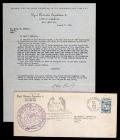

Byrd, Richard E.
Three letters with three envelopes from the Byrd Antarctic Expedition
II (1934-1935). The letters, on official Expedition letterhead, are signed
by Clay Bailey, Chief Radio Operator: two letters are short lines of
holiday greeting and the third is more descriptive of the conditions and
lifestyle at "Little America" -- Byrd's camp in Antarctica. All three
envelopes bear three cent commemorative stamps, cancelled at Little
America, and two have large purple stamps depicting Antarctica next to a
second cancellation featuring penguins delivering mail. Minor soil and
toning. Good to very good condition.
The Second Byrd Expedition was
notable for several reasons: it marked the first time automobile
transportation was an important tool in Antarctic exploration, the first
time voices were broadcast from the Antarctic (a weekly broadcast on CBS
followed shortly after), the first time meteor observations were made at
such southern latitudes and the first significant use of motor-driven
generators to supply electrical power.
Estimated Value $150-200.
Lot 674
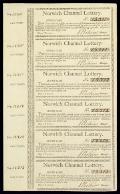

Connecticut Lottery.
Uncut sheet of six lottery tickets for the Norwich Channel Lottery,
circa 1800. Issued by the State of Connecticut, each of these second class
tickets grants one-half of the prize if the ticket's corresponding
number is drawn. Tickets are bordered by rows of foliate designs. Each has
been numbered, as well as signed by lottery manager J. Perkins. Measuring
7½ x 12½". In excellent condition.
Estimated Value
$400-475.
Lot 675
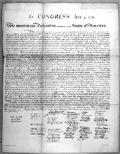

[Declaration of
Independence]. French imprint of the Declaration of Independence.
Printed by the House of Kaeppelin and Son, Paris, after a facsimile by F.
Lapelle. Print size: 23-1/2 x 29-3/8", sheet size: 27 x
34-1/2". Two vertical and two horizontal creases show minor separation and
toning with an area of tape repair on the verso, left edge obviously
trimmed, incidental edge toning, and a small area of foxing at lower
center. Overall, fine condition.
A fabulous opportunity to own a
beautiful early 19th century version of one of America's most important
documents. Available copies of the most famous printed issues of the
Declaration from engraver Stone and printer Force, have well-documented
histories traced almost from date of printing to the present. However, we
are unable to find a thread of provenance for the piece offered here. Our
only clues as to its origins are the printer name at bottom left, the
artist's name at bottom right and "22." printed in the top right corner.
While a good search has found no information about this particular version
of the Declaration of Independence, it exhibits many of the Stone Plate's
idiosyncrasies and the high-quality heavy rag paper (assuredly of 1820-1840
manufacture) on which it is printed emulates the weight of Stone's vellum
more than Force's less substantial rice paper -- suggesting, of course,
that it is closely contemporary with Stone's printing.
Although
there is debate whether the initial French excitement over the American
Revolution was a result of admiration for Americans or hatred for the
British, the French love affair with the Declaration of Independence began
soon after news of the document reached Paris in January 1777. The fervor
with which the ideals embodied in the Declaration were embraced was notable
for its spread through the various classes, as the theories of French
intellectuals like Rousseau, Montesqieu and Voltaire were synthesized into
a single work proclaiming man's inalienable Rights. French involvement in
the Revolutionary War was, in the eyes of the Crown and military, a way to
break the British hold on trade and weaken British influence in Europe and
the New World. To French soldiers fighting in America, who began to adopt
their Colonial collegues' convictions, it became clear that they were
fighting and dying for a concrete notion of liberty and republic -- liberal
ideas that began filtering into the general populace on the soldiers'
return to France. The successful development of the American Republic
offered proof that the Declaration could serve as a catalyst for social
change and kept the document in the forefront of discussions about French
liberty, as unrest in that country built to a crescendo. The pivotal
document of the French Revolution, The Declaration of the Rights of Man and
the Citizen, adopted by the Constituent Assembly in 1789, unabashedly
echoes the Declaration in many ways and thus, the legacy of the Declaration
of Independence in France was firmly established.
Estimated Value
$7,000-8,000.
Lot 676
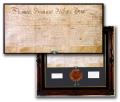

Deed to Thomas and
Richard Penn. Document Signed ("James Hamilton"). As Governor.
One page, elephant folio, Philadelphia, June 10, 1760. On a land grant to
Thomas and Richard Penn. In brown ink. With original, decorative wax
Pennsylvania State Seal affixed to the bottom. Seal features an
encircled tri-bladed symbol with botanical accents and a chevroned edge
attached by a blue ribbon. Handsomely matted and framed to an overall size
of 35 x 31½". With two horizontal and two vertical folds, splitting
along folds, a walnut sized loss of paper at left edge, staining. Seal has
slight losses, but remains almost whole. In fair to good condition
overall.
After inheriting a substantial amount of land from their
father (William Penn), the brothers John, Thomas, and Richard served as
Proprietors of Pennsylvania until 1746. Thereafter, it seems the brothers
began to disperse their holdings. In this land grant, Thomas and Richard
Penn agree to sell a large plot of land to one Samuel Herr. Lieutenant
Governor Hamilton signs the document, attaching the large State Seal of
Pennsylvania.
Estimated Value $750-1,250.
Lot 677
Early American
Indenture. Typed Document Signed. Partially printed, accomplished in
manuscript. One page, oblong quarto, New Brunswick, May 1, 1810. Being an
Indenture. In brown ink. With remnants of a wax seal. Vertical and
horizontal folds, splits along tears, and a few pinpoint losses of paper.
Otherwise, in good condition overall.
This indenture allows John
Kelly, Jr. to learn the trade of a bricklayer as an apprentice to one
Michael Henniger, Jr. for a period of seven years. In part, his duties
include the following: "The said Apprentice his said Master faithfully
shall serve, his secrets keep, his lawful commands every where readily
obey..."
Estimated Value $50-75.
Lot 678
Early American
Insurance Policy. Document. Partially printed, accomplished in
manuscript. One page, folio, Boston, Massachusetts, March 8, 1800. Being a
Policy of Assurance. In sepia ink. Embossed with the Massachusetts One
Dollar Tax seal at the upper left. Three horizontal and two vertical folds,
two pinholes which do not affect text, light stains at top, with a few
areas of foxing. Light toning to the paper, but overall, in good to very
good condition.
This early insurance policy, issued to one Richard
Gilpatrick of Wells, Massachusetts covers the cargo of a ship, named the
Schooner Sally, for $2000 while on its voyage to a port in the West Indies.
Interestingly, calamities covered include: "dangers of the seas, of
fire, enemies, ... pirates, assailing thieves, restraints and detainments
from all kings, princes, or people, ... and all other losses and
misfortunes..."
Estimated Value $75-200.
Lot 679
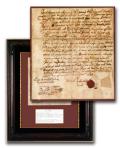

Early American Land
Deed. Autograph Document Signed ("Samuel Sorothrick"). One page,
quarto, Essex, Massachusetts, March 15, 1680. In brown ink. Original wax
seal remains affixed at the lower left. With one horizontal and two
vertical folds, splits along both horizontal folds, several areas of paper
loss, notably to the left of the signature. In fair condition
overall.
Only 60 years subsequent to the Pilgrims' landing in
Massachusetts, this well crafted land deed grants a parcel of land on the
coast of Massachusetts to one Samuel Sorothrick by his father-in-law on
occasion of Samuel's marriage. Interestingly, this rare and early American
land deed was issued just following the separation of New Hampshire colony
from Massachusetts.
Estimated Value $250-350.
Lot 680
Early IRS License.
Internal Revenue Service Business License. In compliance with the new
excise laws of the United States, this license certifies that retail
dealers Camble & Brown have paid the appropriate taxes -- in this case, ten
dollars. Valid for only one year, this certificate was issued on October
11, 1865. Apparently as the license was effective from May 1, 1865 through
May 1, 1866, Camble & Brown appears to have been tardy in compliance.
Measuring 11 x 8½". Foxing at upper right, and a small stain at
lower left, residue from an adhesive remains along upper edge of verso. In
good condition overall.
In order to support the Civil War effort,
Congress enacted the nation's first income tax law in 1862, just three
years prior to the Camble & Brown company's overdue cooperation,
illustrating early disdain for this longstanding law.
Estimated Value
$75-100.
Lot 681
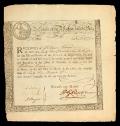

Early Massachusetts Bay
Document. Document Signed ("H. Gardner"?). As Treasurer.
Partially printed accomplished in manuscript. One page, quarto,
Massachusetts, December 1777. On a printed financial note. In black ink.
Three horizontal folds and two vertical folds, time staining, left edge is
trimmed. In good condition overall.
Signed by the Treasurer of the
State of Massachusetts-Bay, this war bond, which features the sword in
hand vignette -- based on designs by Paul Revere --grants one William
Gowen six percent interest.
Estimated Value $400-600.
Lot 682
Early Pennsylvania
Railroad Agreement. Document Signed. One page, two pages, oblong
quarto, Philadelphia, June 8, 1863. Being a mortgage agreement. In black
ink. Docketed on the integral leaf. With original wafer seals affixed to
the second page. With one vertical and three horizontal folds, toning along
folds and a few minor spots. In very good to fine condition
overall.
In this mortgage negotiation, the Pennsylvania Railroad
Company enters a contract with one William Howell agreeing that "they
shall and will reduce the rate of interest from six per centium per annum
to four per centium per annum for the period of four years..." An
attractive document, this interesting record was penned just prior to the
completion of the transcontinental railroad, and the dawning of the
Industrial Revolution. Marking the date, the railroad's own incorporation
seal is boldly affixed to this piece, imprinted with the steam engine that
would become the future of transportation.
Estimated Value $100-150.
Lot 683
Early Philadelphia
Theater Broadside. Printed broadside advertising the Philadelphia
Theatre's final production of "Dramatist!" or, "Stop Him Who Can!" The
event, held on April 24, 1817, was presumably a local production as
indicated by the cast listing (each player is identified by surname only).
Printed by Thomas Desilver, a noted Philadelphia publisher at the time.
Measuring 6½ x 8½", by sight. Framed to an overall size of
11¼ x 14½". Mat burns, two small abrasions at upper left
corner. In good to very good condition overall.
Estimated Value
$150-250.
Lot 684
Early Philadelphia
Theatre Broadside [Junius Brutus Booth]. Printed broadside advertising
the Philadelphia Theatre's production of "Mountaineers". The event, held on
February 17, 1824, featured the actor "Mr. Booth" in his second night of
the performance. Measuring 7 x 10", by sight. Matted and framed to an
overall size of 11 x 15". Mat burns and foxing. Overall, in good condition.
Interestingly, it may be assumed that the stated Mr. Booth, in
actuality refers to Junius Brutus Booth -- father of John Wilkes
Booth. The elder Booth had left England for America in 1821, and began
touring the nation as an accomplished actor, thus placing him in the States
at the time of this performance. In addition, his son Edwin has noted in an
essay on his father that, "...his heroic title, Junius Brutus, was never
used in the playbills with his consent."
Estimated Value $150-250.
Lot 685


Early Sepia Photo of a
Uniformed Mail Man and Horse. Sepia toned, 7 x 5", West Virginia,
1898(?). Handwritten notations appear verso, written by a neighbor
regarding the owner of the farm where this picture was taken. Mounted on
dark background to an overall size of 8¼ x 6". Minor toning at edges.
Otherwise fine condition.
A wonderful piece of postal history, the
exceptional detail of this piece gives us a snapshot of a rural mail
carrier's uniform -- from hat to boots. A complete photographic record of
the items this carrier used to complete his deliveries, this photo captures
the carrier's leather mail bag, black umbrella and rolled up tarp.
Estimated Value $200-300.
Lot 686
Group of Historic
Ephemera. Here we offer the remaining inventory from a life-long
collector's holdings. Included are several typed and handwritten documents
regarding mining, several newspaper illustrations from Harper's
Weekly, and the New York Illustrated News, a portfolio of prints
by "Twelve Israeli Painters", two editions of The Ladies Home Journal
(including a special fall fashion edition), three sepia toned
photographs, three French etchings, a map of Africa, and a Simon &
Garfunkel concert poster. Conditions range from poor to good. Bidders are
strongly encouraged to examine this eclectic lot.
Estimated Value
$250-UP.
Lot 687


Jay Gould Mining
Company, Montana Territory. One remainder stock certificate, 10¾
x 6¾". Certificate number 441 issued by the Jay Gould Company,
selling shares at five dollars each. Floriform border with mining
illustration and various foliate motifs. Near mint condition.
Siding
with Jay Gould in financial matters was rarely a mistake -- the robber
baron made money hand over fist, doing whatever it took to make sure his
ventures were successful.
Estimated Value $50-100.
Lot 688
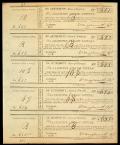

Kentucky Lottery.
Uncut sheet of five lottery tickets issued in 1811 by the State of
Kentucky in order to benefit the Lexington Library. Each ticket, granting
an un-named prize, has been numbered as well as signed by a state agent
named Wigglesworth. Sheet measures 7¾ x 9½". Toning to edges.
Otherwise, in very fine condition overall.
Estimated Value $275-350.
Lot 689
Letter from a Civil War
Soldier. Autograph Letter Signed ("B.F. Hulburd"). Two pages,
recto and verso, octavo, n.p., n.d. In black ink. With two horizontal
folds, heavy soiling. In fair condition overall.
Here, our Civil War
hero exposes an outrage in his camp -- it seems that $450 - 500 dollars
that were to provide the troops with potatoes, onions, butter and cheese
have disappeared from the Quarter Master's office. Hulburd admits: "We
have some officers whose honesty I doubt."
Estimated Value
$100-150.